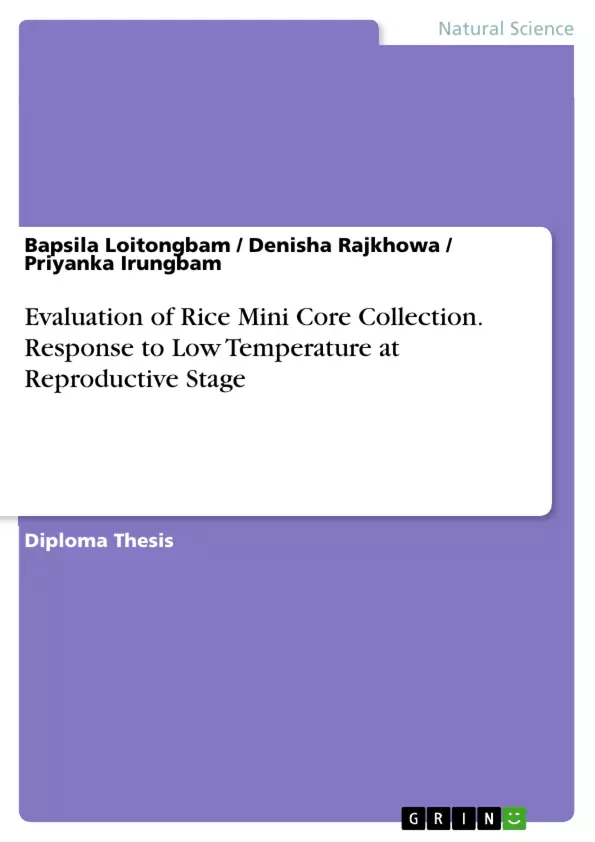Recently, a mini core panel of 98 genotypes representing the diversity of Indian rice germplasm was identified. This mini core is a very important resource that can be evaluated for specific traits of interest to identify superior genotypes that could be used as parents in breeding programmes. The present study was focused on a systematic evaluation of mini core rice collection along with a set of germplasm from the North Eastern Hill Region under cold stress with following specific objectives: To study and compare the effect of three dates of sowing (early, medium and late) on rice mini core collection with respect to yield contributing traits, to determine the trait that most affects yield under stress through path coefficient analysis, to study the effect of cold stress at booting stage on pollen and spikelet fertility under controlled low temperature conditions and to identify tolerant and susceptible genotypes.
Rice farming is the largest single use of land for producing food. Ninety percent of the rice is produced in Asia, and it totaled 696 million tons in 2010. Rice production is one of the most important economic activities on Earth. Only 7% of all rice production is exported from its country of origin.
Various abiotic stresses directly or indirectly affect the physiological status of rice and negatively alter its overall metabolism, often with impacts on grain yield. Cold stress is one of the abiotic stresses which are common problem of rice cultivation. Cold stress causes various injuries to rice seedlings in low-temperature and high-altitude areas and is therefore an important factor affecting rice production in such areas. Rice is a cold-sensitive plant that has its origin in tropical or subtropical areas, and cold damage can cause serious yield losses. Low temperature effects the rice cultivation mainly in two stages of development i.e., seedling and booting. In both of them, cold temperature has harmful effects on crop productivity, as in the first case the number of established plants is affected and in the booting stage pollen sterility can be induced by cold, decreasing the final number of grains.
Inhaltsverzeichnis (Table of Contents)
- ACKNOWLEDGEMENT
- LIST OF TABLES
- LIST OF FIGURES
- LIST OF ABBREVIATION
- ABSTRACT
- INTRODUCTION
- REVIEW OF LITERATURE
- Status and importance of rice
- Effects of cold stress in rice
- Physiological basis of cold tolerance at vegetative and booting stage
- Molecular basis of cold tolerance
- Importance of diverse germplasm core and mini core collections
- Path analysis and principal component analysis for yield contributing traits
- MATERIALS AND METHODS
- Description of the study area.
- Field screening for cold tolerance
- Statistical/Genetic analysis
- Screening for cold tolerance at seedling stage
- Chlorophyll estimation
- RESULTS
- Analysis of variance (ANOVA)
- Analysis of variance for G XE
- Path Analysis studies
- Identification of genotypes tolerant to low temperature
- Relative performance of genotypes under late sown condition as compared to timely sown condition
- Principal Component analysis
- Pollen viability test
- Seedling stage screening for cold tolerance
- Chlorophyll content
- DISCUSSION
- Identification of important traits
- Identification of important genotypes under cold stress at reproductive stage
- SUMMARY AND CONCLUSION
Zielsetzung und Themenschwerpunkte (Objectives and Key Themes)
This thesis aims to evaluate a rice mini core collection for its response to low temperatures during the reproductive stage. This evaluation is crucial for identifying rice varieties that can withstand cold stress and maintain high yields in challenging environments. The study also seeks to identify key traits related to cold tolerance and explore the genetic and physiological mechanisms underlying this resilience.- Identification of cold-tolerant rice genotypes
- Evaluation of the impact of low temperatures on rice yield and yield-contributing traits
- Exploration of the physiological and genetic basis of cold tolerance in rice
- Analysis of the relationship between cold tolerance and other key traits
- Development of strategies for selecting and breeding cold-tolerant rice varieties
Zusammenfassung der Kapitel (Chapter Summaries)
- Introduction: Provides an overview of the importance of rice as a staple food crop, the challenges posed by cold stress, and the significance of evaluating germplasm collections for cold tolerance. The chapter also introduces the specific objectives and research questions of the study.
- Review of Literature: This chapter comprehensively examines existing literature on rice, cold stress, cold tolerance mechanisms in rice, and the use of germplasm core and mini core collections. It also explores the role of path analysis and principal component analysis in understanding yield-contributing traits.
- Materials and Methods: This chapter details the experimental design, study area, materials used, and methods employed for field screening, statistical analysis, and physiological assessments, including chlorophyll estimation. It provides a clear description of the experimental procedures undertaken for evaluating cold tolerance.
- Results: This chapter presents the results of the experimental analysis, including analysis of variance, path analysis, identification of cold-tolerant genotypes, and comparative analysis of the performance of genotypes under different sowing conditions. The chapter also presents data on pollen viability, seedling stage screening, and chlorophyll content.
- Discussion: This chapter interprets the results of the study, highlighting the key findings related to the identification of important traits and genotypes tolerant to low temperatures during the reproductive stage. It discusses the implications of the findings for rice breeding and production in cold environments.
Schlüsselwörter (Keywords)
This thesis focuses on the evaluation of rice germplasm for cold tolerance during the reproductive stage. The key themes and concepts explored include cold stress, cold tolerance, rice yield, physiological mechanisms, genetic analysis, path analysis, principal component analysis, and germplasm core collections.- Quote paper
- Bapsila Loitongbam (Author), Denisha Rajkhowa (Author), Priyanka Irungbam (Author), 2023, Evaluation of Rice Mini Core Collection. Response to Low Temperature at Reproductive Stage, Munich, GRIN Verlag, https://www.grin.com/document/1340515



